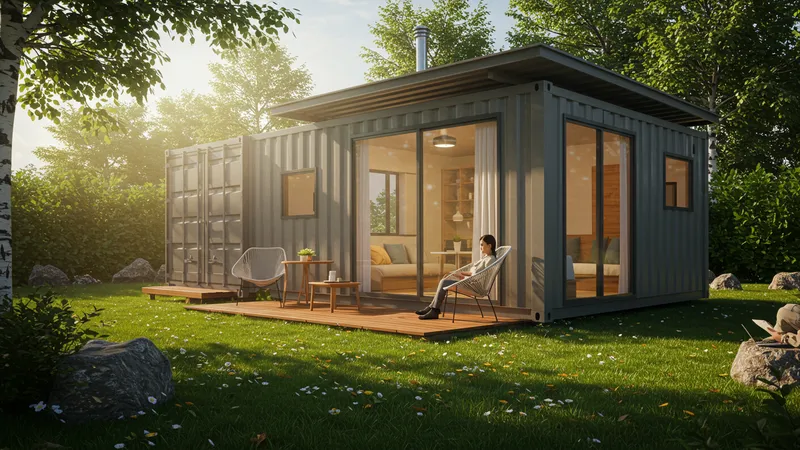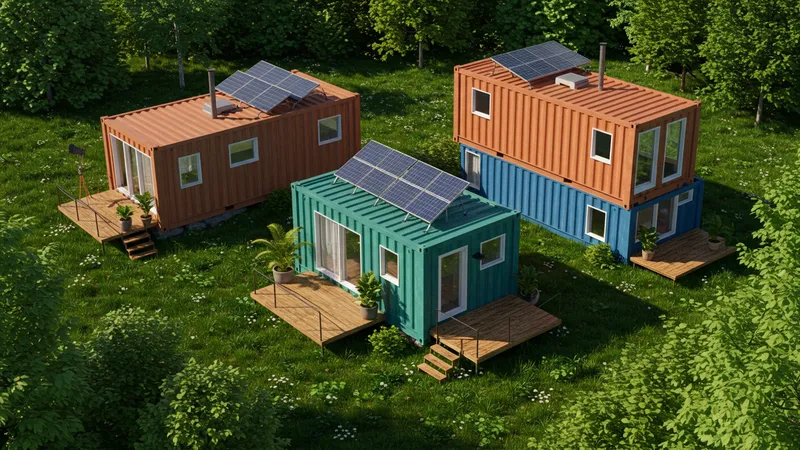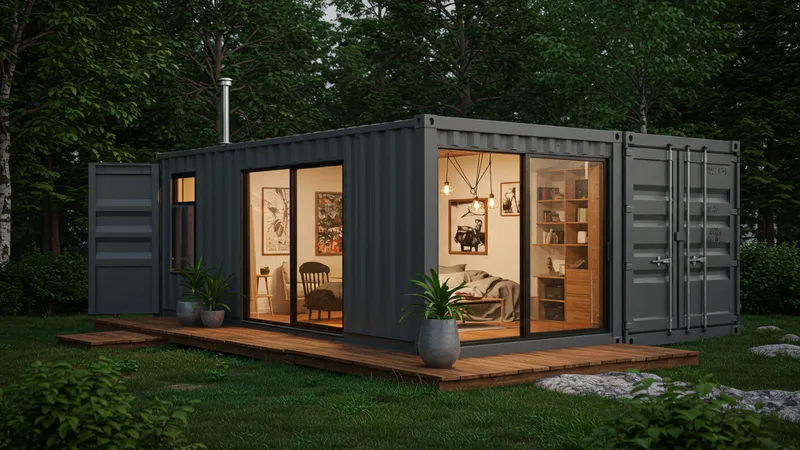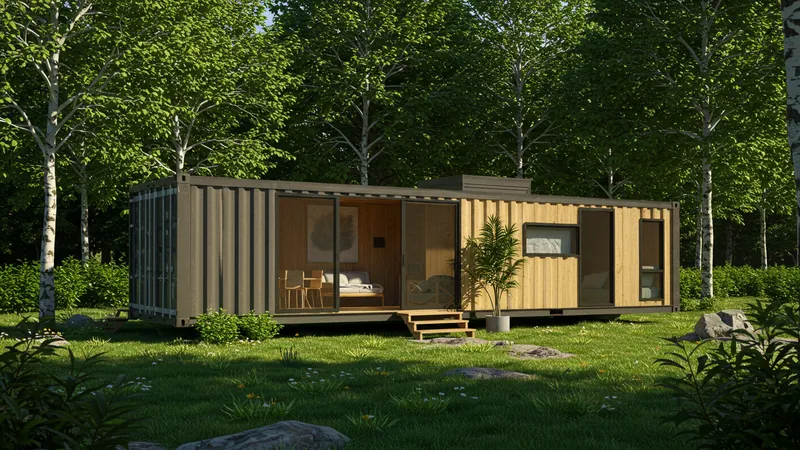

Can you really own a home without a hefty mortgage? Enter container homes, the game-changer no one saw coming. They not only redefine affordable living but also hold a secret that could disrupt the housing industry forever.
Sustainable living has transformed from a mere trend into a necessity, pushing us to seek alternatives — fast. Container homes promise eco-friendliness and cost-efficiency. But why is now the absolute perfect time to consider this housing option?

Imagine constructing an entire home for a fraction of your expected budget using old shipping containers. It sounds absurd at first, but these steel boxes have proven to withstand typhoons, earthquakes, and even extreme weather conditions. Shipping containers are being repurposed not just as homes, but as luxury retreats, stunning cafes, and even pop-up shops, making container architecture more than just a budget-friendly choice. But that’s not even the wildest part…
What if I told you these homes are customizable to suit any taste or style while maintaining a keen focus on sustainability? Homeowners are delighting in creating unique floor plans, integrating modern amenities, and delivering high-end finishes. All this while reducing their carbon footprint significantly. Yet, this versatility barely scratches the surface of what container homes can offer. Prepare yourself, because you’re about to uncover aspects of container living you never saw coming.
The affordability of container homes is astonishing, but their potential doesn’t stop there. The utilization of a container home can revolutionize personal finance and environmental impact. You're about to discover how these unconventional homes can shift paradigms in ways financial advisors never anticipated. What happens next shocked even the experts…
When it comes to affordable housing solutions, container homes take the crown. By converting these used steel boxes into livable spaces, you tap into an extensive cost-benefit unknown to traditional homeowners. Picture investing a fraction of the typical home's cost, yet getting all the essentials plus unique charm. Unlike traditional mortgage chains, these homes are often financed without the sky-high interest rates, making them accessible to more people. On top of that, they depreciate far slower than conventional homes, securing your investment. Could this be the smarter financial move you’ve been seeking?

Surprisingly, container homes offer more than just an entry point into homeownership; they significantly reduce long-term housing expenses. Maintenance costs plummet as these homes are designed with durability in mind, handling weather adversities better than most traditional structures. The steel framework minimizes repair costs typically associated with water damage, termites, or even mold. For anyone looking to slim down their annual expenses, container homes reveal an unbeatable option. But there’s one more twist to this financial tale…
A significant yet understated advantage lies in the resale value of these homes. Where conventional homes may lose value over time due to market volatility, container homes retain their worth due to robust materials and growing popularity. Many owners find - often to their amazement - that their container homes are an appreciating asset. Think about it: with a rising global focus on sustainable living, the demand for such eco-friendly residential solutions is set to soar. Don’t just take our word for it; see what happens when demand starts outpacing supply…
Another intriguing aspect is their adaptability, which adds layers of financial advantage. With properties traditionally built in fixed formats, altering layouts can be costly. However, container homes allow you to reconfigure spaces effortlessly and affordably, whether it’s doubling up or expanding a unit. With such flexible personalization, homeowners can easily adjust their living situations to match their life phase, without incurring the heavy costs of moving or reconstructing a traditional property. What you read next might change how you see this forever.
In an era plagued by the environmental strain of our actions, container homes shine as a beacon of eco-responsible living. These homes repurpose unused shipping containers, offering a solution to the massive industrial waste plaguing our planet. Astonishingly, each contained structure utilizes the equivalent of nearly 7,000 pounds of upcycled steel, encompassing an astonishing sustainability tale. By opting for a container home, individuals buy into a lifestyle that reduces carbon emissions by placing less pressure on conventional building materials and methods. Have you ever wondered how your living choices can directly fight climate change?

Furthermore, container homes facilitate eco-friendly practices by seamlessly integrating renewable energy systems. Many designs include solar panels, rainwater harvesting setups, and energy-efficient installations as standard, resulting in marked decreases in energy dependency and lower utility bills. For those craving an independent and sustainable lifestyle, container homes deliver an exciting alternative that walks the green talk. Yet, the environmental perks of these homes don’t end with sustainable materials and energy self-sufficiency…
Consider the smaller footprint - literally and environmentally - due to their compact nature. Even as their cozy size sparks debate, the reduction in space is exactly what contributes to fewer resources’ consumption. That means less land occupied, lowered heating and cooling costs, and a minimized impact on the earth's strained resources. As the global population continues to soar, container homes readily offer scalable solutions that challenge sprawling suburban development. What would our dilapidated planet look like if everyone adopted this minimalist ethos?
Let’s not forget the community impact of container living, which extends beyond personal ecological advantages. Urban lots once deemed unsuitable or wastelands can be transformed into thriving living spaces with little environmental disturbance. Moreover, container homes support urban density by creating livable spaces on previously unused land, fostering sustainable neighborhood growth and social interaction. Could you handle that kind of surprise? It’s a revelation, indeed, that reshapes our understanding of sustainable urban living.
When it comes to container homes, creativity is your only limit. Unshackled from the rigidity of traditional designs, these homes offer unparalleled freedom in personal styling, functional layouts, and aesthetic appeal. Want a bright, airy living area with floor-to-ceiling windows? Or perhaps a cozy nook replete with modern conveniences? With modular units and custom configurations, container homes can take any form you desire, often at a fraction of the cost and time of conventional builds. How would you reinvent your living space if anything was possible?

One of the most striking aspects of container homes is their adaptability to various architectural styles without sacrificing the core functionality or comfort. Be it rustic exteriors with lush green facades or sleek, minimalist interiors adorned with smart technologies, the design choices are as varied as they are innovative. Container homes eliminate constraints and let homeowners explore unconventional depths of personal expression and luxury. How far are you willing to take your creative freedom in a home?
The notion that container homes are inherently simple is another delightful misconception. Sure, they start as utilitarian structures, but that’s precisely where the magic lies. With minimalistic interiors cleverly curated for efficiency, every inch serves dual purposes, ensuring that even small spaces boast versatility and visual interest. Whether it's a rooftop garden, a cozy mezzanine bedroom, or a chic office, these designs optimize compact living. For many, that’s a paradigm of design genius in itself. But there’s one more twist to the whimsical world of shipping container living…
The innovation doesn’t halt at interiors. Externally, these homes boast roughened steel that gives character and resilience, but they are also perfect canvases for avant-garde architecture. Cantilevered formations, stacked designs, and creative use of colors transform what might appear as a dull industrial box into an artistic statement. From adding multiple stories to blending containers into the natural landscape, the possibility of living in your truly ‘one-of-a-kind’ home becomes thrillingly real. What would you create if given ultimate design power?
Shipping container homes have captured the imagination of thousands across continents, inspiring remarkable architectural feats and transforming mundane structures into global design icons. In the Netherlands, for instance, a colossal student dormitory managed to maximize limited space with container housing, providing chic, affordable accommodations. Such implementations showcase the potential of container homes beyond personal residences, unveiling novel solutions for densely populated regions. Who would have thought these weathered boxes could harbor global potential?

Moreover, Australia has become a breeding ground for masterfully designed container homes that blend seamlessly into the rugged landscapes. From airy coastal villas to streamlined urban cocoons, these homes marry traditional aesthetics with contemporary functionality. As Australians seek to tackle both affordability and environmental sustainability, container architecture seems like a match made in paradise. How else do you think container living is challenging the norms in unexpected places worldwide?
Countries like Costa Rica spearhead initiatives that employ container homes for disaster relief, due to their sturdy, stackable nature. When faced with natural disasters, these easily deployable shelters offer quick solutions and comfort without compromising durability. The added bonus? They often occupy existing shipping routes, saving crucial resources and time. Could shipping containers redefine emergency response and humanitarian housing forever?
Creative uses of container homes extend even further, captivating wanderlust-filled minds with pop-up hotels and mobile cafes. In Japan, sleek capsule hotels and quirky cafes boast minimalist sophistication, converting passing trend into cultural phenomenon. As global citizens look to redefine conventional living and traveling norms, container homes offer a spectrum of possibilities. What might a city's architectural fabric look like with these innovative additions?
Tiny homes initially sparked curiosity as a creative loophole within housing laws but have burgeoned into a full-fledged movement challenging contemporary housing ideals. Container homes fit harmoniously into this narrative, drawing a segment of society eager to dismantle the status quo of oversized living. Their compact form harmonizes with the principles of minimalism, advocating for life's essentials while slashing superfluous consumption. As society's perspective shifts towards ‘less is more’, will container homes redefine luxury for the masses?

Several enthusiasts have embraced container tiny homes for their reduced construction times, allowing potential homeowners to pivot from blueprint to dwelling in record time. With traditional home builds stretching into years of waiting, container homes slash that to mere weeks or months. Imagine enjoying the freedom of homeownership sooner than you ever dreamed. Could this expedited timeline be the future standard in housing development?
In addition to their charmingly small stature, container homes boast superior mobility. Adventurous spirits seize the opportunity to place their homes on wheels, offering a life of boundless exploration without losing the comfort of familiarity. As people appreciate the value of experiences over material accumulation, will this customizable mobility become the next age of residential revolution? What stirs inside you at the idea of taking your home across horizons?
Interestingly, the compact size encourages innovative use of space, where designers deliver increasingly inventive solutions for functional living. With clever loft bedding, murphy desks, and collapsible furnishings, utility meets creativity at every corner. The small dimensions unravel new perspectives of functionality, proving that a smaller canvas breeds infinite imagination. Thinking about tiny homes, have we underestimated the sheer power in their scaled-down simplicity?
For a generation drowning in student debt while grappling with stagnant wages and skyrocketing real estate prices, container homes open a new chapter of financial liberation. Owning a home need no longer be an unattainable dream. Millennials are latching onto this reimagined housing paradigm, relishing the freedom of owning space without forgoing security or style. Does the era of constricting 30-year mortgages face imminent demise?

Embracing philosophies of minimalism and sustainability often attributed to millennials, container homes align seamlessly with modern lifestyles targeting genuine living over material encumbrance. Agile, efficient, and driven by purpose, these homes become extensions of identity over mere constructs of residence. The resonance between millennial values and container living sparks an exploration of non-traditional paths, marking the future with new standards. But what if I told you these won't just be homes, but trails to financial independence?
Initially unassuming, container homes hold a unique appeal to environmentally conscious young adults seeking sustainable alternatives. Every container repurposed mitigates an equivalent disposal of eco-unfriendly materials, granting peace of mind to home buyers. The emphasis on green building solutions and energy-saving technology resonates strongly with millennial expectations, fusing eco-conscience with innovation. Are container homes more than just aspirational dwellings? Are they the crux of a growing ‘green’ rebellion?
Missing from many modern housing solutions is the unparalleled mobility container homes propose. Migratory by nature, millennials unwilling or unable to tether themselves, benefit from homes that transition smoothly across geographies. Changing careers, pursuing studies, or chasing adventures made simple, continue to seduce the nomadic streak within our prevalent global citizens. Is this sustainable mobility a window into the true desirability of container homes for this tech-savvy generation?
For investors keen on growth and sustainability, container homes present lucrative prospects. As materials cost outstrips traditional metrics, investing in container housing arms you with a financially sound strategy that anticipates growing consumer trends. With land scarcity and building costs soaring, container homes secure an entryway into diversified portfolios. Anticipate rippling returns in this burgeoning market where recycling meets profitability. Does your investment strategy include the changing face of real estate?

Unlike many volatile markets, the container housing sector sits firmly tethered to sustainability—a profound asset for investors conscientious about both potential profit margins and ecological impact. The conscientious investor discovers the double-edge of fiscal gain and green advocacy, marrying calculated risk with social responsibility. Could this eco-aligned investment have farther-reaching benefits than traditional real estate opportunities?
Even with financial allure, it's the potential for rapid property 'flipping' that captivates seasoned investors. A container home conversion, thanks to minimal construction timelines, turns expectations around in dazzling speeds. Immediate returns from minimal initial outlay challenge the pace of gains typical to brick-and-mortar developments, ensuring high liquidity in asset turnover. Are fast gains and eco-conscious incentives enough to tip investor scales towards container potential?
For those who broaden their horizons, international advances in container living hint at untapped resourcefulness. Region-specific demands—be it compact urban apartments, sustainable coastal retreats, or disaster response units—invite investment into a versatile medium beyond restrictive normatives. Investing in container homes traverses cultural and economic boundaries, nurtures innovation, and could have a profound long-term impact. What would you do in this situation, witnessing such comprehensive capability?
It’s hard to deny—container homes, once seen as mere alternatives, are crafting industries of their own. As pioneers of sustainable living, these homes continue to surprise with leaps in eco-technologies, promising enhancements and efficiency without losing affordable charm. Upgraded thermal insulation, green roofing, or hydroponic systems elevate a conventional container home from rudimentary to revolutionary, challenging industry mindsets. Could this evolution in design redefine the trajectory of affordable housing globally?

The vision extends past residential confines, with architects exploring community-styled arrangements where container homes efficiently unite shared spaces, promoting urban green belts, multi-use zones, and innovative communal spaces. As advancements take root, container villages may very well become bustling hubs of cultural exchange and social connectivity—a new vision for public interaction. Could the ethos of container living truly reshape community architecture however we envisage?
The prospects of container homes extend into the realm of technological boundary-pushing too. Experiments with smart home integrations, eco-ID sensing, interactive automation, and modular enhancements mean personalized, futuristic living spaces that reflect individual preferences. Could these innovations spearhead a new wave of technologically advanced living spaces ultimately zipping past traditional standards in compatibilities and conveniences?
With emerging global trends toward environmental viability, container homes align themselves within realms of inclusive, sustainable development. Governments and private sectors may convene to incentivize such housing efforts, creating an unprecedented blend of fiscal benefits and sustainable practices. Will global standards view container homes as the optimal solution in housing scarcity and environmental responsibility?
As pragmatic and practical as container homes appear, misconceptions abound. Many skeptics argue their compact size limits adaptability, yet innovations continually put such concerns to rest. Concise design principles and adept use of space ensure functionality soars where traditional layouts may otherwise fall short. By tackling concerns with tangible solutions, have we overcome the myths of confined living once and for all?

Structural safety is another common myth easily debunked. Containers are designed for global shipping, ensuring their robust construction can withstand harsh conditions and climates. Engineers reinforce these properties while accommodating residential needs, presenting living options safeguarded by their intended integrity. Will these facts elevate containers from misunderstood boxes to accepted fortress homes, reframing popular belief on durability?
Longevity and lifespan are yet another debated issue; many believe steel transcends time as opposed to traditional materials at risk of decay. With mindful maintenance and weather-proofing, the durability of container homes commands equal, if not better, life expectancy. Interestingly, the potential to recycle containers post-residency leaves an environmental legacy that few materials can boast. Will widespread acceptance of container homes bridge the gap in perceived sustainability versus the realities of enduring construction?
The notion of luxury sparked debate in container circles, where insinuations of less yielding luxury ensued. Yet, evolving design proofs brim with contemporary fittings, bespoke furnishings, and lavish finishes, accounting for exceptional prestige. As taste-makers veer toward clean lines and understated elegance, could the status of container homes swiftly transit from affordable option to coveted designer choice?
The integration of technology in container home development is not merely a bonus but a necessity for creating harmonious living environments. Smart technologies capitalize on the unique structural attributes of containers, ushering in an era where homes are more than shelters—they’re personalized technological companions. Adaptive energy solutions, ambient intelligence, and AI-driven security systems contribute not simply to ease, but enhance the spatial dynamics of these homes. Have you wondered how technology redefines the habitation narrative for future generations?

3D printing introduces another dimension to container homes, accelerating the rapid prototyping of components and encouraging advancements in niche construction materials. Interior elements can undergo design flexibility according to personalized specifications, creating a truly bespoke experience for every homeowner. Aside from innovation, does this tech insertion steer container development toward a new frontier in customization?
Virtual reality and augmented reality now alter the way homeowners interact with their spaces, offering simulations of layout modifications or aesthetic variations before committing to physical changes. This symbiosis of digital and tangible dimensions empowers owners to visualize and tweak their habitat to harmonize with real-world requirements. In essence, VR and AR provide boundless opportunities in personal satisfaction and tailored living solutions. Will virtual insights shape the physical execution of our container-based future homes?
Energy-efficient technologies and systems promise owners energy consumption insights, optimizing energy harnessed from alternative, renewables such as solar and wind. This not only slashes ongoing operating expenses but aligns homes with environmental strategies championed globally. The increased reliance on sustainable energy generators bolsters the stance of container homes as genuine torchbearers of green living. Does technological utility finally establish container homes as pivotal to our ultimate energy sustainability goals?
Constructing container homes presents unique challenges when it comes to navigating building regulations and permits. These hurdles often arise from traditional views yet require a novel approach to compliance, as each container proposition trails its unique set of complexities. Engaging with a pre-emptive mindset eases encounters with local planning authorities and modifies antiquated systems. Anticipating regulatory shifts, could you envisage a smoother path for alternative housing solutions established in the norm?

Establishing close alliances with professionals familiar with local building regulations creates a solid grasp of how containers align within existing frameworks. Acquiring mastery in paperwork ensures seamless navigation throughout the approval process while minimizing delays or unforeseen snags. Acutely understanding prerequisite documentation secures compliance and establishes peace of mind for homeowners fiercely ambitious about their dreams. Could expert collaboration remove barriers to achieving housing aspirations?
Furthermore, proactive community engagement becomes beneficial in addressing concerns and misconceptions. Preemptive dialogues elevate understanding of the benefits container homes offer, dissolving apprehension, and fostering goodwill among neighbors. Being visible and vocal stars open-minded discussions, slowly transforming skeptics into allies. Would a more transparent approach build bridges instead of walls spanning container habitats and traditional homesteads?
International examples underscore quintessential best practices in ethically navigating bureaucratic spaces, as global case studies showcase improbable triumphs of container-oriented ambitions. Tailoring local customs, constraints, and opportunities to create workable solutions harmonizes environmental, aesthetic, and legal concerns. How else can cross-border successes provide invaluable insights for globally unified advancements in container development processes?
One would expect container homes to be simplistic in their raw essence, yet the marriage of materials and sustainability behind these homes speaks otherwise. Standardization of resilient steel frames juxtaposes new-age green construction methodologies to birth residences that are both sustainable and modern. Able to resist the tests of time and weather, container materials promise superb insulation through environmental-friendly solutions meeting global standards. Were you aware of the extraordinary results of this elemental fusion?

Eco-conscious builders favor materials sourced responsibly, enhancing insulation, or exterior aesthetics by incorporating modular elements, bamboo interiors, or recycled cladding. Such choices satisfy sustainability ethos and enhance environmental efficiency, fine-tuning their mission toward the industry's net-zero goal. Possessing avant-garde technology, energy-independent homes push boundaries, inviting expansion of ecological construction practices. What else elevates these homes above standard models, positioning them on the cutting edge of green development?
Exciting collaborations between architects and researchers enrich container homes via materials optimization, pursuing solutions like aerogels or vacuum-insulated panels, breaking new ground for thermal efficiency. Exploring futurist ideas and sustainable developments underscore humanity's keen edge over inefficiencies in the housing sector. How might innovative breakthroughs redefine the way we perceive—and live—within container homes?
Container homes encourage ongoing exploration into sustainable renovations as owners experiment with smart technologies and reclaimed components. Possibilities widen, breaking apart traditional concepts of home construction methodologies. As civic awareness heightens across the globe, could these explorations yield further benefits to both container owners and the broader community, catalyzing a paradigm shift in how we approach dwellings?
In a world grappling with housing affordability and sustainability challenges, container homes emerge as revolutionary solutions that redefine both concepts. Their fusion of adaptability, eco-consciousness, and financial sensibility crafts an alluring alternative, one that inspires broader engagement beyond conventional architecture. As the world disentangles from rigid traditions and adopts more fluid living principles, container homes illuminate a path towards a future where affordability and sustainability are not mere options but standards.
Embrace the movement, explore the charm of container living, and challenge the status quo. Share these stories, bookmark this journey, and take action — because the transformation in housing landscapes has just begun, and you have the power to shape it.